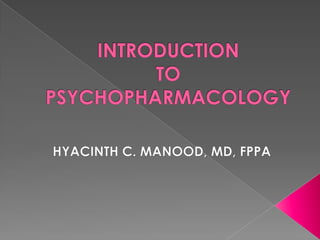
Introduction to psychopharmacology
- 1. INTRODUCTION TO PSYCHOPHARMACOLOGY HYACINTH C. MANOOD, MD, FPPA
- 2. GENERAL PRINCIPLES: Classification Pharmacological Actions Pharmacodynamics Pharmacokinetics Metabolism and Excretion Clinical Guidelines Special Treatment Considerations Adverse Effects Discontinuation or Withdrawal Syndrome Intoxication or Overdose
- 3. CLASSIFICATION Psychotropic, psychoactive, or psychotherapeutic drugs 4 traditional categories: 1)antipsychotics, 2)antimanic or mood stabilizers, 3)antidepressants, 4)antianxiety or anxiolytics
- 4. Many drugs of one class are used to treat disorders previously assigned to another class. Drugs from all four categories are used to treat disorders previously not treatable by drugs. Some non-psychiatric drugs can treat a variety of psychiatric disorders effectively but do not fit easily into the traditional classification. e.g., Clonidine, Gabapentin, Propanolol Some descriptive psychopharmacological terms overlap in meaning. eg. Anxiolytics also have sedative effects
- 5. Pharmacological Actions Pharmacodynamics Effects of the drug on the biological activities of the body. Receptor mechanism Therapeutic index Dose response curve Development of tolerance, dependence, and withdrawal phenomena
- 6. Receptor– the cellular component to which the drug binds and through which the drug initiates its pharmacological effects on the body. Dose Response Curve – plots the drug concentration against the effect of the drugs. POTENCY – the relative dose required to achieve certain effects. CLINICAL EFFICACY – the max clin. Response achievable by administration of a drug
- 7. Therapeutic index - a relative measure of the toxicity or safety of a drug - ratio of the median toxic dose to median effective dose. median toxic dose – dose at which 50% of patients experience a specific toxic effects median effective dose – dose at which 50% of patients experience a specified therapeutic effect.
- 8. Pharmacokinetics How the body handles the drug. Absorption : Orally administered drugs dissolve in GIT fluids and are then absorbed in the blood – then reach the brain. Parenteral administration more rapid than oral Depot preparations – emulsified in an insoluble carrier matrix sustaining the drug’s gradual release through IM administration IV administration is the quickest route but carries the highest risk of sudden and life-threatening adverse effects.
- 9. Distribution and Bioavailability Protein-bound – bound to plasma proteins Free – if the circulate unbound Only the free fraction can pass thru the BBB High CBF, high lipid solubility, and high receptor affinity promote therapeutic actions of the drug Volume of distribution- measure of apparent space in the body available to contain the drug. Bioavailability - the fraction of the total amount of administered drug that can be subsequently recovered from the bloodstream.
- 12. CYTOCHROME P450 ENZYMES Most psychotropic medications are oxidized by hepatic CYP enzyme system. Act primarily in ER of hepatocytes and cells of the intestines. Cellular pathology in these sites may affect the efficiency of drug metabolism by the CYP system Certain drug combinations should be done so with caution or should be avoided. Long half-lives prolong inhibition of CYP system
- 13. Clinical Guidelines: Choice of Drug Diagnosis and identification of target symptoms Drugs currently taken and recently discontinued Supotimal dosage of appropriate drugs
- 14. Special Treatment Considerations A. GERIATRIC PATIENTS -older persons may be especially susceptible to adverse effects -slow metabolism B. CHILDREN - small volume of distribution - higher rate of metabolism
- 15. C. PREGNANT AND NURSING WOMEN - the two most teratogenic drugs in psychopharmacology are LITHIUM and the ANTICONVULSANTS. Lithium – birth anomalies like Ebstein anomaly Anticonvulsants – fetal craniofacial and neural tube anomalies - Risk of teratogenicity is lowered by administration of FOLIC ACID
- 16. D. PERSONS WITH HEPATIC AND RENAL INSUFFICIENCY: - drugs may accumulate to toxic concentrations. - reduced dosage, usually half the recommended dose. - monitor plasma drug concentrations E. PERSONS WITH OTHER MEDICAL ILLNESSES - increased sensitivity to adverse effects - altered metabolism - interactions with other medications
- 17. Adverse Effects Sexual dysfunction – most commonly associated with the use of SSRI. Tx. Shift to Nefazodone or Bupoprion Anxiety, Akathisia, and Insomnia – SSRI and antipsychotics. Tx. Benzodiazepines, Anticholinergics, shift to non SSRI antidepressants GI upset and Diarrhea – Sertraline most likely to cause loose stools, Fluvoxamine most likely to cause nausea; Tx. Begin with low dose, adm drug after eating, BRAT diet.
- 18. Headache – SSRI; Tx: ovr the counter analgesics Anorexia – SSRI Weight gain – atypical antipsychotics bec. of disturbance in glucose and insulin metabolism TX. Diet Somnolence – desirable adverse effect Dry Mouth – caused by blockade of muscarinic acetylcholine receptors Tx. Chew sugarless gum, 1% solution of Pilocarpine as mouthwash 3x a day
- 19. Urinary Retention – anticholinergic activity Tx. Betanechol 10 -30 mg once or twice daily Constipation – Tx. Laxatives, Betanechol Orthostatic hypotension – caused blockade of a1-adrenergic receptors. TX. Instruct patient to get up slowly and sit down immediately if dizziness is experienced. Avoid caffeine Drink at least 2 Liters of fluids daily adding salt to food reassess dosages of antihypertensive meds
- 20. Discontinuation Syndrome – transient emergence of mild symptoms upon the discontinuation or reduction of dosage SSRI . TCAC’s, Lithium, DRA, Benzodiazepines Lithium – rebound mania DRA – tardivedyskinesia Benzodiazepines – anxiety and insomnia SEROTONIN DISCONTINUATION SYNDROME Agitation, nausea, dysequilibrium and dysphoria Symptoms are time-limited Minimized by gradually reducing the dosage